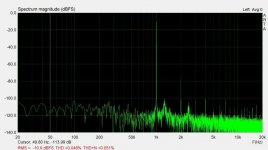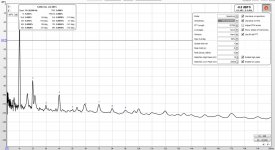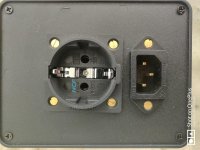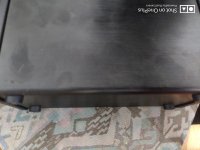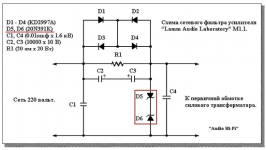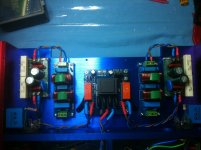vmk2002 Do not worry, everyone started somewhere and there were failures. They will correct you if something goes wrong.😉😀
You're quite right. Aliexpress Technical Support Team has impressive record of providing expert customer advices 24/7/365. 🙂vmk2002 Do not worry, everyone started somewhere and there were failures. They will correct you if something goes wrong.😉😀
Over the past year or so I’ve spend the most of my time learning how to make amplifier silent and how to measure its silence. That’s a complex area and I have found here at this site a plenty of information to achieve the goal of completely silent amplifier. The most notable information was provided by xrk971, Bonsai, Prasi and ilimzin. Excuse me if I have omitted anyone but my time was limited and the amount of available reading on this subject here is really extensive.
Also, measurement of noise and distortion is quite complex and may require quite a large expenditure, perhaps too large a bite for a diyers' budget. So I went along the road suggested here by xrk971:
https://www.diyaudio.com/forums/sof...-distortion-measurements-rew.html#post5806493
Below you may see a single measurement of a smaller sister of A-60 amplifier, with "just" three pairs of output transistors. The snapshot represents this amplifier in the most adequate way. First note that THD is larger than 0,02% but the distortion is predominantly 2nd order whilst the rest of harmonics are below the audible region. At lower power the 2nd order distortion also vanishes below the audible region. This characteristics, the absence of harmonics above the 2nd, makes the sound pleasant. Also, response to square wave produces almost ideal rectangular shapes even at as low as 10 Hz. This explains why this amplifier has really good, clear, solid bass, exactly in the same octave as it should be. (To me some other amplifiers sound hollow because their bass sounds like it was transposed into a higher octave). This one keeps the bass exactly where it belongs - down. (Please note that I avoid the term "deep bass" because bass is as deep as it is, just some amplifiers tend to reproduce it an octave higher.)
There is however a shortcoming: beautiful sound is limited to about 11 Vrms into 8 Ohms. From this point on, the amplifier departs the class A region and the distortion starts to increase. It is possible to extend this region of pleasant sound but it isn't worth it because the increase of the quiescent current above 200 mA requires substantial heat sinking.
For my taste this amplifier has awesome sound and has everything required: soft start, speaker protection and power supply. In this particular case I have used hifisonix ripple eater for mx amplifier so I was able to make proper connection to the safety ground.
Therefore I have decided to use it with +/-24V rails which provide enough power for pleasant listening in a 30 m3 room, more than enough for average listening habits.
Furthermore I have substituted some devices:
Instead of 2SA1943/2SC5200 I have used MJL1302/MJL3281
Discontinued 2SC2705/2SA1145 replaced with 2SC3423(2SA1360 (ISC)
The missing MJE15034/15035 replaced with MJE15032/MJE15033 available from my stock.
I have not made the above substitutions to achieve "better sound quality", rather to use adequate devices. What I've found is that it is possible to achieve pleasant listening experience with adequate selection of power supply and proper wiring - There is no need for any exotic parts, just ordinary stuff from reliable supplier.
Also, measurement of noise and distortion is quite complex and may require quite a large expenditure, perhaps too large a bite for a diyers' budget. So I went along the road suggested here by xrk971:
https://www.diyaudio.com/forums/sof...-distortion-measurements-rew.html#post5806493
Below you may see a single measurement of a smaller sister of A-60 amplifier, with "just" three pairs of output transistors. The snapshot represents this amplifier in the most adequate way. First note that THD is larger than 0,02% but the distortion is predominantly 2nd order whilst the rest of harmonics are below the audible region. At lower power the 2nd order distortion also vanishes below the audible region. This characteristics, the absence of harmonics above the 2nd, makes the sound pleasant. Also, response to square wave produces almost ideal rectangular shapes even at as low as 10 Hz. This explains why this amplifier has really good, clear, solid bass, exactly in the same octave as it should be. (To me some other amplifiers sound hollow because their bass sounds like it was transposed into a higher octave). This one keeps the bass exactly where it belongs - down. (Please note that I avoid the term "deep bass" because bass is as deep as it is, just some amplifiers tend to reproduce it an octave higher.)
There is however a shortcoming: beautiful sound is limited to about 11 Vrms into 8 Ohms. From this point on, the amplifier departs the class A region and the distortion starts to increase. It is possible to extend this region of pleasant sound but it isn't worth it because the increase of the quiescent current above 200 mA requires substantial heat sinking.
For my taste this amplifier has awesome sound and has everything required: soft start, speaker protection and power supply. In this particular case I have used hifisonix ripple eater for mx amplifier so I was able to make proper connection to the safety ground.
Therefore I have decided to use it with +/-24V rails which provide enough power for pleasant listening in a 30 m3 room, more than enough for average listening habits.
Furthermore I have substituted some devices:
Instead of 2SA1943/2SC5200 I have used MJL1302/MJL3281
Discontinued 2SC2705/2SA1145 replaced with 2SC3423(2SA1360 (ISC)
The missing MJE15034/15035 replaced with MJE15032/MJE15033 available from my stock.
I have not made the above substitutions to achieve "better sound quality", rather to use adequate devices. What I've found is that it is possible to achieve pleasant listening experience with adequate selection of power supply and proper wiring - There is no need for any exotic parts, just ordinary stuff from reliable supplier.
Attachments
There is however a shortcoming: beautiful sound is limited to about 11 Vrms into 8 Ohms. From this point on, the amplifier departs the class A region and the distortion starts to increase. It is possible to extend this region of pleasant sound but it isn't worth it because the increase of the quiescent current above 200 mA requires substantial heat sinking.
People may find this phrase highly discouraging since the amplifier in review is a Class-B amp thus it must be exhibit its actual performance in Class-B region. If not, it means that this amplifier suffers badly from crossover distortion.
Thanks Terra for this important remark. Could be worse above, say 20 watts , but from the very beginning I've planned to scale this down because I don't need lots of power, my intention is rather to extract the best sound from it. I have tried it with just a single pair and it works well. It sounds and measures too like JLH amplifier just has much better bass performance. I don't skimp, just want to make rational design decision that suits my needs. I don't intend to provide amplification for Wembley stadium, just for my room and a single pair of devices could be suited for the purpose.People may find this phrase highly discouraging since the amplifier in review is a Class-B amp thus it must be exhibit its actual performance in Class-B region. If not, it means that this amplifier suffers badly from crossover distortion.
Have a pleasant Sunday evening dear Terranigma.🙂
I don't intend to provide amplification for Wembley stadium, just for my room and a single pair of devices could be suited for the purpose.
So, let me invite you to the Circlophone club. An unique topology, runs in virtual Class-A mode (no crossover distortion) with dead silent output even at full power.
Have a pleasant Sunday evening dear Terranigma.🙂
Thank you Berlusconi. It would be more pleasant if it was a Friday evening.
Terranigma,So, let me invite you to the Circlophone club. An unique topology, runs in virtual Class-A mode (no crossover distortion) with dead silent output even at full power.
Thank you Berlusconi. It would be more pleasant if it was a Friday evening.
Thanks, three times. First for the invitation to the Circlophone Club. I'm in. Second, for making me smile about Friday, but don't worry, Friday comes again, after a hard working week that expects me.
Now, thank you again. Without your initiative I wouldn't have even tried to extract more than just 20 watts of fine sound from A60. After your remark I have tried again, this time with +/-37V rails and look at the pleasant surprise below. 50 Watts of pleasant sound into 7,5 ohms (perhaps even more but I didn't want to go further this late in the evening). Just look at the distribution of harmonics: the 2nd dominates, the 3rd is almost non-existent and the 4th is just at the border of audibility. Again, this explains me why I loved the sound of this amplifier from the first moment. It creates just a mixture of even harmonics. Slowly, I will understand what mixture of harmonics sounds pleasant to my ears.
And, don't forget to go to the bed earlier - tomorrow is Monday, again. 🙄
Attachments
Last edited:
Hi Berlusconi. Tell me, do you have power transformers in A60 + Chinese? Have you used a DC mains filter for toroidal transformers (inside the amplifier case or external filter). Thank you.
I have tested both: it is possible to connect transformer directly to the board or to an external rectifier to have much lower noise floor. If you decide to do so connect + to the leftmost terminal, ground to the next terminal and - to the third from the left.
But I may recommend you to avoid complications at the initial stage: Just simply connect the board to the toroidal transformer. I did it this way:
orange - connected to the first terminal from the left
yellow and green wires go together to the second terminal
blue wire connects to the third terminal
Caution. However, colors may be different - use a multimeter to find adequate pairs of wires in your transformer. This board has very well grounding including a star connection located below the four capacitors and this board will not cause additional problems with eliminating hum.
But I assume you have problems with the noise. This comes most probably from the input connection which must be properly shielded and properly connected. I use ordinary two wire LIYCY cable. Locate the RCA connectors as close as possible to each other on the chassis and connect their grounds. Then lead the both wires (pairs) together to the input of one channel and then go the shortest way with another wire to the second channel. If this isn't enough then connect input terminals with 1K resistor on the both channels.
You might expect a simple recipe to eliminate noise but there is no such thing. There is a whole science behind this problem. You have to learn. I have already gave you a link to an article at hifisonics.com. Go there and learn how to do that. Otherwise buy yourself a commercial amplifier, read instruction manual, connect it to the mains and push the power button. See, even this isn't that simple.
It is impossible to use some general layout because our amplifiers are different although we use the same board. What matters is the geometry of your board and internal connections. You must learn otherwise you will fail. That's not just in this case. This is how the real world runs. Learn or fail. There is no a free lunch.
Good luck
But I may recommend you to avoid complications at the initial stage: Just simply connect the board to the toroidal transformer. I did it this way:
orange - connected to the first terminal from the left
yellow and green wires go together to the second terminal
blue wire connects to the third terminal
Caution. However, colors may be different - use a multimeter to find adequate pairs of wires in your transformer. This board has very well grounding including a star connection located below the four capacitors and this board will not cause additional problems with eliminating hum.
But I assume you have problems with the noise. This comes most probably from the input connection which must be properly shielded and properly connected. I use ordinary two wire LIYCY cable. Locate the RCA connectors as close as possible to each other on the chassis and connect their grounds. Then lead the both wires (pairs) together to the input of one channel and then go the shortest way with another wire to the second channel. If this isn't enough then connect input terminals with 1K resistor on the both channels.
You might expect a simple recipe to eliminate noise but there is no such thing. There is a whole science behind this problem. You have to learn. I have already gave you a link to an article at hifisonics.com. Go there and learn how to do that. Otherwise buy yourself a commercial amplifier, read instruction manual, connect it to the mains and push the power button. See, even this isn't that simple.
It is impossible to use some general layout because our amplifiers are different although we use the same board. What matters is the geometry of your board and internal connections. You must learn otherwise you will fail. That's not just in this case. This is how the real world runs. Learn or fail. There is no a free lunch.
Good luck
Last edited:
Hi Berlusconi. I respect your opinion. But I asked a little about something else. I have a problem like this. Transformers hum, and you can hear it if you are near the amplifier case (I'm not talking about sound in acoustics). On the forums they write that this is possible due to the presence of a constant voltage in the 230V alternating current network. Google translated my question incorrectly. So, there are special filters, for example:
AIYIMA 2000W 15A EMI Power Filter Module AC110V 265V High Efficiency DC Power Supply Filter DIY Audio Sound Home Amplifiers|Amplifier| - AliExpress
Have you ever used one? Maybe someone from the forum participants will say for and against such filters. I will be grateful.
AIYIMA 2000W 15A EMI Power Filter Module AC110V 265V High Efficiency DC Power Supply Filter DIY Audio Sound Home Amplifiers|Amplifier| - AliExpress
Have you ever used one? Maybe someone from the forum participants will say for and against such filters. I will be grateful.
DC blocker
To stop humming transformer because there is DC on the mains you need something like this.
https://www.hifisentralen.no/forumet/attachments/img_20210209_122457-jpg.696186/
To stop humming transformer because there is DC on the mains you need something like this.
https://www.hifisentralen.no/forumet/attachments/img_20210209_122457-jpg.696186/
@Erlend @vmk
You're right Erlend, as usual.
vmk, here is an article for you:
Mains DC and Transformers
You're right Erlend, as usual.
vmk, here is an article for you:
Mains DC and Transformers
Eliott
But I am sure I can hear both the treble and bass get better. The large Sjøstrøm DC blocker with 6 X 68.000 uf.
But I am sure I can hear both the treble and bass get better. The large Sjøstrøm DC blocker with 6 X 68.000 uf.
🙂Thanks Erlend for the info on "large Sjøstrøm DC blocker with 6 X 68.000 uf". Could you please provide more information on this. I am particularly interested in purchasing a PCB because I also have an arsenal of large capacitors (you never know when you will need them).But I am sure I can hear both the treble and bass get better. The large Sjøstrøm DC blocker with 6 X 68.000 uf.
I believe this could improve the sound, as you say, because amplifier modulates current coming from the power supply. Good, stable source of current ensures better sound. Similar effect comes from using capacitance multipliers. Sound is generally better.
Last edited:
Erlend Sæterdal did you come to 6x68.000μF experimentally (did you have transformers humming?) Or did you find a ready-made solution? If there was a ready-made solution, would you give a link to the finished product?
Your looks like a mains filter and not a DC blocker. The big blocker have very low ESR and that's also important for powerfull bass in a big amplifier.
- Home
- Amplifiers
- Solid State
- A60(+) Amplifier. Build this?
